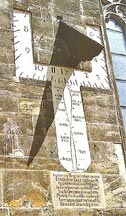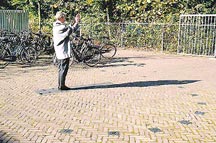Bay Life ~ Summer’s Here
Celebrate the Solstice by Keeping Track of Old Sol
by Sonia Linebaugh
Where’s that sun been all spring? All this rain has converted Chesapeake Country to a nation of sun worshipers.
June 21 is the feast of that tardy fellow, old Sol.
It’s the solstice, which means the day the sun stands still. Of course that’s not quite true. The sun — or rather we — keeps right on moving. This day, when the sun is at its greatest distance from the celestial equator, is better described as a turning point, for this is the time when — after six months of ascending into the longest hours of light — we begin our six-month descent into the longest hours of night.
 Other cultures have prayed and danced for rain. Could it be that a little attention would bring some sun our way?
Other cultures have prayed and danced for rain. Could it be that a little attention would bring some sun our way?
In that vein, and just in time for the solstice, we suggest an activity that gives a whole new meaning to the phrase sun worshiper: Building a sundial.
Whether or not your attentions propitiate the sun, you’ll gain new understanding of time while working on your sundial. You’ll learn, as many have long suspected, that time-keeping is an arbitrary business.
You’ll learn new respect for measurement, math, the equation of time, the difference between apparent local time and mean solar time and the relationship of your body to time.
Naturally, it’s a project you’ll have to give some time to.
Where on Earth Are You?
To begin, you have to know exactly where on earth you are. That means not just a place name but latitude. For instance, Crofton is at 39.011°N, while Mayo is 38.891°N. Those minutes — the percentages of a degree — make a difference in telling true time.
In finding your latitude, as in much of the process of making a sundial, we’re following the direction of the British Sundial Society. Look under Beginners on their web page, www.sundialsoc.org.uk.
For latitudes, the Sundial Society site makes an easy link to the Census Bureau. All you have to know is your zip code.
Put in your latitude as directed and download a simple paper version of an analemmatic sundial specific to your latitude. Here’s where you’ll see the shape of your project. In the continental U.S., it will be an ellipse whose width is different depending on that all-important latitude. For instance, a Mayo sundial will be slightly wider than a Crofton sundial. A Portland, Maine, sundial is slightly closer to a circle.
To see what your result might look like, while you’re on-line visit www.biol.rug.nl/maes for photos of an analemmatic sundial that Frans Maes built in his garden in the Netherlands. Maes has also collected photos of sundials from all over the world.
Now, it’s time to turn to the real world. You’ll need 24 12-inch patio pavers; white paint and paintbrush; sticks, stones and string.
Next, you’ll need to discover where celestial north is. This task will take you out on a clear night.
Stand in the middle of the spot where you want to put your sundial and find the Big Dipper. The two stars on the front of the dipper (away from the handle) point to the north star, named Polaris, the bright single star that holds the center of our night sky.
Lay a row of stones or a long stick on the ground pointing to Polaris. This is your north-south axis. Now you know where on Earth you live. But you’ve got a way to go to tell what time it is.
 Catching the Sun
Catching the Sun
Wait till daytime to build your sundial.
First, you’ll mark the east-west axis by laying another row of stones or a long stick directly across this line to point east-west. Make this line as long as the widest part of your dial. (You can use math for a more accurate east-west axis.)
Put sticks into the ground at both ends of the east-west axis and stretch a taut string between the sticks. Do the same for the north-south axis.
To mark the hours, you’ll need to scale-up your analemmatic sundial print-out to real size. Let one inch on paper equal two feet on the ground.
For the hour marker, you can use sticks, stones, pavers, gazing balls — whatever you like. You’ll need 12, to mark the progress of the sun from 6am till 6pm. Place the hour markers according to your scaled-up plan, painting the hour numbers in white.
But that’s not all: Earth tilts, and its relationship to the sun changes over the year, so you have to add month markers along the north-south axis. Again, you can make these calculations for your latitude on the British Sundial Society program. Use something you can stand on, or over — like pavers — for these markers.
Once all markers are in place — and the sun shines — you’re ready for the big test of time. You enter the picture now, playing the role of the gnomon (say NO-mon), the shadow-casting pointer in a sundial.
Standing the Test of Time
Stand on the marker for the correct month, hold your arm straight up and note where your shadow falls. At noon it should fall straight ahead onto the 12 marker.
 Compare your time with a clock.
Compare your time with a clock.
No, they don’t agree. Why?
Probably it’s the clock’s fault, according to the British Sundial Society.
Sundials rarely agree with clock time, and that’s because of the difference between local apparent time and mean time.
On May 27, 2003, the sun rose in Portland, Maine, at 5:05am and set at 8:11pm. In Cleveland, Ohio, it rose at 5:58am and set at 8:49pm. But both cities are in the Eastern time zone and set their clocks for the same time.
Eastern Daylight Time, which both cities follow this time of year, is based on a standard meridian somewhere in the middle of the time zone, just west of Cape May Point, New Jersey. This standardization makes it easy to be on time for your plane, train or job. But it isn’t sun time.
To add to the confusion, Earth tilts on its axis and wobbles eccentrically as it rotates around the sun. Information about all these differences is gathered together into a formula called the Equation of Time. You’re on your own to learn more.
But that’s more than you need to know, anyway.
Now, you only need to know when you should expect your sundial to point to noon. Luckily, Bay Country is not far from the center of the Eastern Time zone, just west of Cape May Point. That puts us off the mark by only three minutes. The hour difference is due to Daylight Savings Time. Noon reaches Chesapeake Country at just about 1:03pm clock time.
If you haven’t retreated behind dark glasses or to a cold drink in a dark barroom, you’re ready to try it for yourself.


 Other cultures have prayed and danced for rain. Could it be that a little attention would bring some sun our way?
Other cultures have prayed and danced for rain. Could it be that a little attention would bring some sun our way? Catching the Sun
Catching the Sun Compare your time with a clock.
Compare your time with a clock.